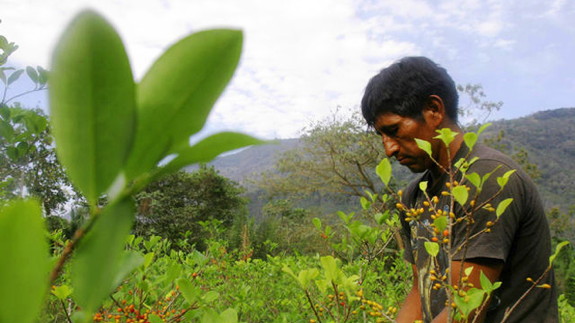
(above) Freddy Pari, 40, picks coca seeds to sell on a street market in the village of La Asunta, some 200 km (124 miles) east of Bolivian capital La Paz. (AP Photo/Dado Galdieri)
Bolivia Touts Coca Flour As Way For Addicts To Kick Habit
August 21, 2013 - Fox News Latino
Bolivia has already developed a type of beer using the base product of cocaine, but the Andean nation wants to further diversify its controversial coca crop into a market that literally deals in "dough."
At the Fourth International Coca Leaf Forum, hosted by the Bolivian government in the capital of La Paz, the international drug policy expert Martin Jelsma of the Transnational Institute said that mild doses of the stimulant coca – such as that in cooking flour made from coca – could help drug addicts kick their habit to cocaine.
"We must seek opportunities to influence the market. It has been very difficult to reduce the international market for strong, illegal stimulants illegal, " he said, according to EFE news agency. But you can make "an attempt to recapture that market with mild stimulants that are controlled and lawful."
Jelsma noted that coca flour is not only seen as a more acceptable alternative stimulant than chewing coca leaves, but could also be exported more easily to other countries than the bulky leaves.
Coca, the base substance in the production of cocaine, has been used for centuries by people native to the high Andean region as a stimulant and to ward off the debilitating effects of altitude sickness. While it is traditionally rolled up and chewed, it has also become popular to concoct a tea out of the plant.
Bolivia is one of a number of Latin American nations that has flirted with the legalization of some drugs.
While the country has reduced its coca crop for the second year in a row, the government of President Evo Morales, a former coca grower, continues to butt heads with the United States over its anti-drug efforts.
Coca supporters like Morales point out that indigenous communities have for centuries chewed coca to fight off the effects of altitude sickness and fatigue and use it in religious rituals.
A 1975 Harvard University study also found the leaves to have a surprisingly high nutritional value, rich in calcium, iron and vitamins A, B2 and E. However, it said the "toxic alkaloids" comprising 0.25 to 2.25 percent of the plant "could make the nutritious coca leaf undesirable as a source of nutrients."
U.S. counter-narcotics officials insist most of Bolivia's coca crop goes to cocaine production and say the country has also become a haven for Colombian drug traffickers who also use Bolivia to refine coca paste imported from Peru.
Bolivia has the world's third-largest coca crop after Peru and Colombia, with more than 67,000 acres under cultivation, according to the U.N. Office on Drugs and Crime. Unlike Colombia, however, most of its cocaine heads not to the United States but to Brazil, Argentina and Europe.